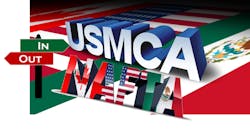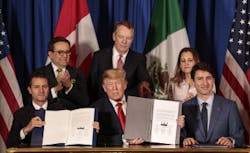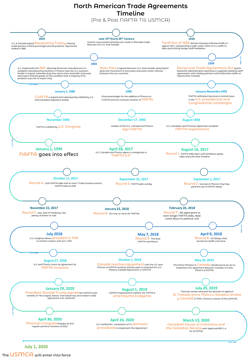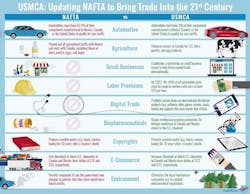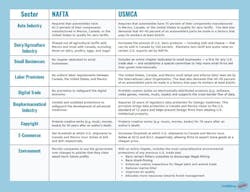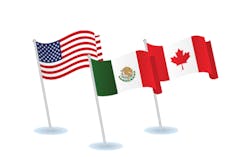The long-standing North American Free Trade Agreement #NAFTA comes to an end on June 30, 2020 and morphs into the United States-Mexico-Canada Agreement #USMCA, solidifying the United States, Mexico and Canada trade partnership into one of the world’s biggest such agreements. Free trade has helped Mexico and Canada to become America’s two largest trading partners while helping the U.S. retain its status as the leading trading partner among its neighbours. The USMCA brings an updated perspective to NAFTA, resulting in more balanced, reciprocal trade that will continue to grow the North American economies.
The USMCA is a compromise, as all trade agreements are, but negotiators could not arrive at a consensus on what to call it. In the United States, it is the USMCA, but in Canada, the order has been changed to put Canada first (as it were). Ottawa refers to it as the Canada-United States-Mexico Agreement #CUSMA in English and Accord Canada-États-Unis-Mexique #ACEUM in French. In Mexico, the Spanish version is El Tratado entre México, Estados Unidos, y Canadá #T-MEC.
Background of the subject
On January 1, 1994, NAFTA entered into force. The world of global trade was different then, and NAFTA promised prosperity to its member nations by progressively reducing tariffs on qualifying, originating goods as well as removing other barriers to trade and investment among the three nations.
At its inception, NAFTA immediately eliminated tariffs on more than one-half of Mexico's exports to the U.S. and more than one-third of U.S. exports to Mexico. It further eliminated the merchandise processing fees (MPF) on eligible products, enhanced intellectual property protections and promoted conditions for fair competition among the three nations.
While NAFTA achieved many of its objectives, especially in Mexico’s transition to a middle-income country and an industrial powerhouse, the agreement lacked an expiration or renewal date, and ongoing controversies regarding the treatment of certain product sectors became the focal point for change. Despite its successes, NAFTA drew criticism for diminishing jobs in the U.S. market, the perceived transfer of much of the automotive sector to Mexico, purported worker exploitation in Mexico and insufficient environmental protections in that country as well. This opened the path to modernizing NAFTA into a more strategic agreement, reflective of the current economies within the three countries.
USMCA Modernizes NAFTA into a 21st Century Trade Agreement
The USMCA modernizes trade among the three nations in multiple ways, resulting in mutually beneficial partnerships that will support economic growth in the region and reduce the U.S. trade deficit with Mexico. The following are highlights of the agreement:
- Innovative rules of origin that will increase manufacturing in the North American region: With the introduction of new rules of origin and the raising of the maximum allowable de minimis content exception from 7% to 10% for most items, products that did not qualify under NAFTA may now qualify under the USMCA. This provides new opportunities for firms not previously qualifying for preferential treatment under NAFTA that are now eligible under USMCA. In the automotive sector, the qualifying percentage of North American content for passenger vehicles will increase from 62.5% to 75% to qualify for zero tariffs. Updated rules for the textile industry limiting the use of inputs from outside the North American region will favour "made in the USA" fibres, yarns and fabrics.
- Key sectoral liberalizations on certain agricultural quotas: Certain dairy and sugar products will enjoy liberalized quotas if they originate in one of the three USMCA signatory countries. This should prove beneficial not only for producers and exporters but also for the cost structures of the users of these products.
- Newly-created guidelines for digital trade: E-commerce and digital trade were not widespread when NAFTA was signed. The USMCA chapter on digital trade addresses this with a robust set of predictable rules to protect member countries while providing opportunities to expand the digital trade economy. Most notable is the prohibition of customs duties on digitally-exchanged products such as eBooks, videos, software and games. The agreement promotes collaboration in addressing cyber-security challenges, which supports security requirements of the updated U.S. cargo security program, the Customs-Trade Partnership Against Terrorism (CTPAT), as well as the Canadian Partners in Protection (PIP) and Mexico’s Authorized Economic Operation (AEO) program. The USMCA further supports the protection of confidential information belonging to consumers and businesses with enforceable measures.
- Labour provisions to protect workers: The new chapter on labour provisions outlines enforceable labour standards as a core part of the agreement. Mexico has agreed to enact legislation specific to its labour laws that will include prohibitions of goods made by forced or compulsory labour along with protective measures for workers, especially the most vulnerable. Additional oversights have been introduced to promote compliance, including the use of a Rapid Response mechanism allowing independent panels to initiate an investigation of a covered facility in lieu of a government inspection.
NAFTA's Impact on the U.S. Economy
The USMCA carries forward the strong relationships among its members that help preserve the economic prosperity and cultural ties developed over the last 26 years under NAFTA. Equally important is the stability the USMCA brings to the region through shared supply chains.
Proximity always matters, same theory applied here. Transacting business globally means increased transportation costs, greater opportunity for supply chain disruptions and longer lead times. The benefits of shared borders and shorter transportation times between countries has resulted in an interdependent manufacturing process whereby intermediate goods flow out and finished goods return.
NAFTA Certificate Elimination
One major change under the USMCA occurs in Chapter 5 with the elimination of the NAFTA Certificate of Origin requirements, which should alleviate what came to be an administrative burden for many exporters to — and importers from — NAFTA countries. Formerly, not only did a corporate employee at the exporter of record have to sign the certificate, but he or she also had to assume individual liability for any errors in the certificate or lack of supporting records.
The new guidelines mandate that the parties provide certain key data points concerning the shipment’s origin but no longer will they be required to prepare and produce the NAFTA-formatted Certificate of Origin. The required data points may be provided on the commercial invoice or any other document and must describe the originating goods in sufficient detail to enable their identification. It must also be clear how the goods meet the origin requirements as set out in the uniform regulations.
One significant difference from NAFTA is who can certify the shipment as USMCA-qualifying. Under NAFTA, the certificate was signed by the exporter of record. Under the USMCA uniform regulations, the certified can be the importer, exporter or producer as noted in Article 5.2: Claims for Preferential Tariff Treatment. To ensure the accuracy of duty reduction claims, the certified must provide contact information that includes phone and email in addition to the required statements and data points to qualify, although no specific form is required.
To avoid accidental mis-declarations for preferential origin, it is recommended that exporters include a general statement of “non-qualification” on the commercial invoice when exporting. For example, an exporter in the United States shipping U.S. products to Canada, without having qualified the article, could insert a statement on the invoice stating the product “has not been qualified under any global free trade agreement” to avoid having the Canadian importer erroneously claim the product as qualifying under the USMCA.
"Passage of this agreement is critical for U.S. manufacturing sector. Canada and Mexico are manufacturers’ most important partners." Linda Dempsey, Vice President, International Economic Affairs, National Association of Manufacturers (NAM)
Sunset Provision
Another compelling difference is that, unlike NAFTA, the USMCA has as expiration period or sunset provision, which provides for the review of the trade agreement to ensure it is benefiting all members as planned. This provision recognizes that the USMCA is a living, evolving agreement meant to achieve something NAFTA could not — that the members will maintain the relevancy of the agreement and that it continues to reflect the latest trade trends. The agreement’s successes and challenges will be reviewed every six years and member countries will have an opportunity to make adjustments. The sunset provision also allows for members to withdraw from the agreement or continue to remain active.
Preparing for the USMCA Implementation
As the July 1, 2020, implementation is just around the corner, it is imperative that companies take immediate action to move from NAFTA to the USMCA program. To ensure continuity from one program to the next, companies should consider taking the following actions:
- Review and understand the new rules of origin, since many products previously ineligible for NAFTA qualification may now qualify for preferential treatment under the USMCA — or the reverse.
- Increase training on the new requirements of the qualification process. While the fundamental concepts of tariff shift and regional value content carry over, new origin rules have been introduced. For example, the de minimus for non-qualifying components has been increased, with certain exceptions, which may impact a firm’s qualifying process.
- Develop and enhance classification skills under the Harmonized Schedule (HS) through ongoing training. The correct classification code is the basis of product origin rules. Any erroneous classification can yield an improper product qualification under both NAFTA and USMCA.
- As there is no longer a standard certificate under USMCA, create a company-approved USMCA form for qualifying products to ensure a consistent approach to the company’s process and reduce the risk of noncompliance. Ideally, certifies of a specific product should avoid signing another company’s form or certification request using language not approved by their own firm.
- Maintain supporting records for the applicable time-frame outlined under NAFTA rules, with the understanding that NAFTA claims may still be audited after the implementation of the USMCA.
- Consider trade agreement management software to assist with the qualification, vendor solicitation and administration of USMCA to benefit from all the opportunities the new agreement provides from day one.
The agreement’s successes and challenges will be reviewed every six years and member countries will have an opportunity to make adjustments. The sunset provision also allows for members to withdraw from the agreement or continue to remain active.
